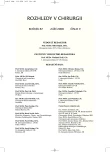Six-Month Functional and X-Ray Outcomes of Distal Radius Fractures Managed Using Multidirectional Locking Plates
Authors:
Martin Vlček; P. Višňa
Authors‘ workplace:
1. ortopedická klinika 1. LF UK a FN Motol, Praha, přednosta kliniky: prof. MUDr. A. Sosna, DrSc.
Published in:
Rozhl. Chir., 2008, roč. 87, č. 9, s. 486-492.
Category:
Monothematic special - Original
Overview
Introduction:
Distal radius fractures remain the commonest fractures in the human body. Developed countries have recorded increasing rates of these fracures.
Material and methods:
The authors assess results of distal radius osteosynthesis procedures using the Aptus® Radius 2.5 mm (Medartis, Schweiz) system, consisting of 18 types of multidirectional, locking plates, designated for osteosyntheses and corrective osteotomies of the distal radius. The authors evaluate six- month results in 66 patients operated from January to September 2007. All AO types of fractures were included in the study group.The mean age of the patients was 49.5 years.
Results:
According to X- ray, the mean healing time was 7 weeks. 6 moths following the procedure, the radius length was +0.4 mm (ranging from + 4 mm to – 4 mm), the radial inclination was 21° (ranging from 13°to 29°) and the palmar tilt of the articular surface was 7° (ranging from 0° to 10° of the palmar tilt). The range of motion, compared to the other extremity, was as follows: palmar flexion 87.5%, dorsal flexion 91.5%, radial duction 90.5%, ulnar duction 88.2%, pronation 98.1% and supination 94.3%. The mean grip strength reached 85% of that of the contralateral extremity.
Discussion:
Fragment-specific fixation using the Aptus radius system, provides enough stability to prevent secondary loss of correction. Functional and radiological outcomes were similar to those with other types of locking plates. The results obtained from this study correspond to data presented in other recent studies assessing multidirectional locking plates.
Conclusion:
Central, targeted fixation of the fracture fragments and introduction of locking screws provide stability, which minimizes duration of additional fixation and facilitates early rehabilitation. It can be used for osteosynthesis of all types of fractures according to AO classification and, in particular, optimizes fixation of the C.2. and C.3. fracture types.
Key words:
distal radius – fracture – osteosynthesis – multidirectional – locking plates – fragment-specific fixation – Aptus
Sources
1. Hagino, H., Yamamoto, K., Ohshiro, H., Nakamura, T., Kishimoto, H., Nose, T. Changing incidence of hip, distal radius, an produmal humerus fractures in Tottori Prefecture. Japan. Bone, 1999, 24, 256–270.
2. Owen, R. A., Melton, L. J., Johnson, K. A., Ilstrup, D. M., Riggs, B. L. Incidence of Colles‘ fractures in a North American community. Am. J. Public Health, 1982, 72, 605–607.
3. Pilz, P., Lindemann-Sperfeld, L., Winter, S., Otto, W. Distale Radiusfracturen. Trauma Berufskh, 2000, 2, 313–319.
4. van Staa, T. P., Dennison, E. M., Luefkens, H.G., Cooper, C. Epidemiology of fractures in Engaland and Wales. Bone, 2001, 29, 517–522.
5. MacDermid, J. C., Roth, J. H., McMurtry, R. Predictors of time lost from work following a distal radius fracture. J. Occup. Rehabil., 2007, 17(1), 47–62.
6. Schnall, S. B., Kim, B. J., Abramo, A., Kopylov, P. Fixation of distal radius fractures using a fragment-specific system. Clin. Orthop., 2006, 445, 51–57.
7. Gofton, W., Liew, A. Distal radius fractures: nonoperative and percutaneous pinning treatment options. Orthop. Clin. North Am., 2007, 38(2), 175–185.
8. Kurup, H. V., Mandalia, V., Shaju, A., Beaumont, A. Bicortical K-wires for distal radius fracture fixation: how many? Acta Orthop. Belg., 2007, 73(1), 26–30.
9. Moser, V. L., Prommersberger, K. J., Pessenlehner, CH., Meier, M., Krimmer, H. Anterior fixed angle plate fixation of unstabile distal radius fractures. Operat. Orthop. Traumatol., 2004, 16, 383–396.
10. Ring, D., Prommersberger, K. J., Jupiter, J. B. Combinated dorsal and volar plate fixation of complex fractures of the distal part of the radius. J. Bone Joint Surg., 2004, 86-A(8), 1646–1652.
11. Ruch, D. S., Ginn, T. A., Yang, CH. C., Smith, B. P., Rushing, J., Hanel, D. P. Use of a distraction plate for distal radial fractures with metaphyeal and diaphyseal comminution. J Bone Joint Surg. Surgical Technique, 2005, 87(5), 945–954.
12. Letsch, R., Infanger, M., Schmidt, J., Kock, H. J. Surgical treatment of fractures of the distal radius with plates: a comparison of palmar and dorsal plate position. Arch. Orthop. Trauma Surg., 2003, 123(7), 333–339.
13. Arora, R., Lutz, M., Zimmermann, R., Krappinger, D., Gabl, M., Pechlaner, S. Limits of palmar locking-plate osteosynthesis of unstable distal radius fracture. Handchir. Mikrochir. Plast. Chir., 2007, 39(1), 34–41.
14. Chung, K. C., Watt, A. J., Kotsis, S. V., Margaliot, Z., Haase, S. C., Kim, H. M. Treatment of unstable distal radial fractures with the volar locking plating system. J. Bone Joint Surg. Am., 2006, 88(12), 2687–2694.
15. Krimmer, H., Pessenlehner, C., Hasselbacher, K., Meier, M., Roth, F., Meier, R. Palmar fixed angle plating systems for instable distal radius fractures. Unfallchirurg., 2004, 107(6), 460–467.
16. Murakami, K., Abe, Y., Takahashi, K. Surgical treatment of unstable distal radius fractures with volar locking plates. J. Orthop. Sci., 2007, 12(2), 134–140.
17. Mehling, I., Meier, M., Schlör, U., Krimmer, H. Multidirectional palmar fixed-angle plate fixation for unstable distal radius fracture. Handchir. Mikrochir. Plast. Chir., 2007, 39(1), 29–33.
18. Kakarlapudi, T. K., Santini, A., Shahane, S.A., Douglas, D. The cost of treatment of distal radius fractures. Injury, 2000, 31, 229–232.
19. Macdermid, J. C., Roth, J. H., Richards, R. S. Pain and disability reported in the year following a distal radius fracture: a kohort study. BMC Musculoskelet Disord, 2003, 4, 24.
20. Pechlaner, S., Gabl, M., Lutz, M., Krappinger, D., Leixnering, M., Krulis, B., Ulmer, H., Rudisch, A. Distal radius fractures-aetiology, treatment and outcome. Handchir. Mikrochir. Plast. Chir., 2007, 39(1), 19–28.
Labels
Surgery Orthopaedics Trauma surgeryArticle was published in
Perspectives in Surgery

2008 Issue 9
Most read in this issue
- Fractures of Sternal End of the Clavicle – Current Concept Review
- Cystic Neoplasms of the Pancreas
- Acute Abdomen Following Duodenal Biopsy
- Thoracoscopic Thymectomy – Initial Experience
